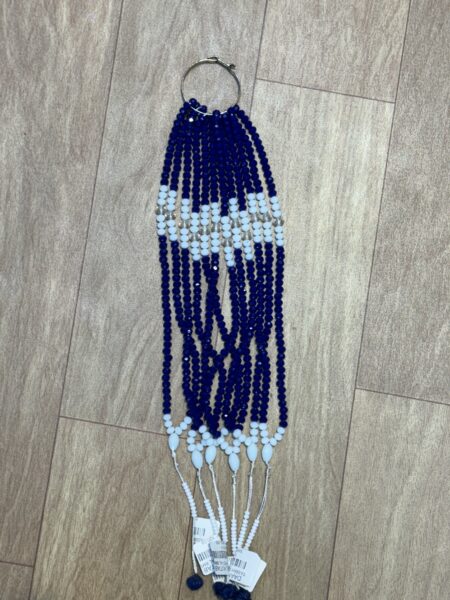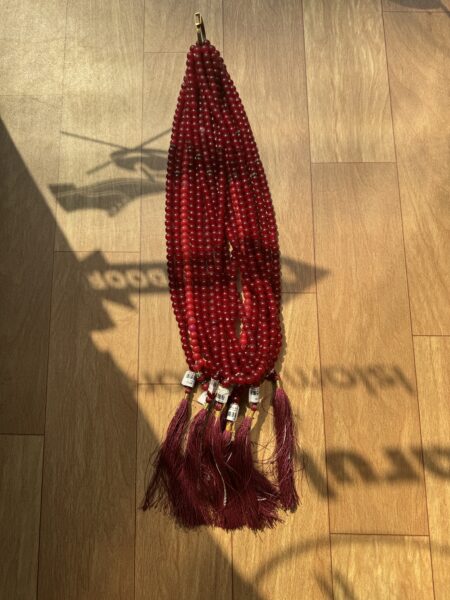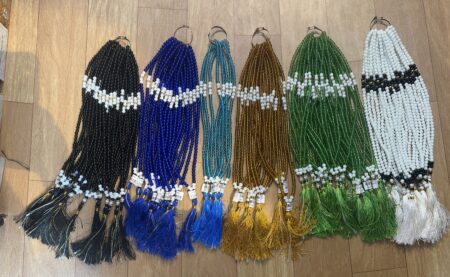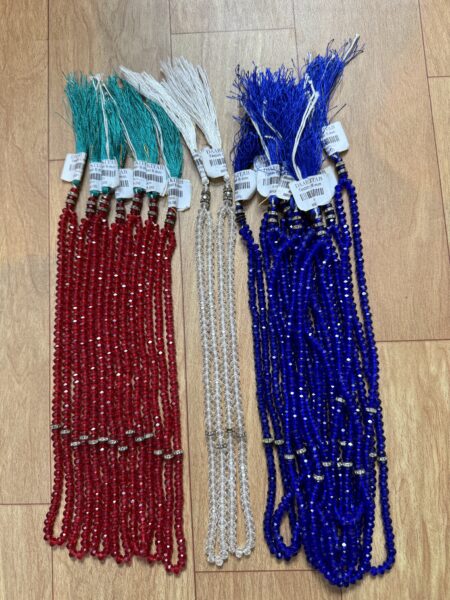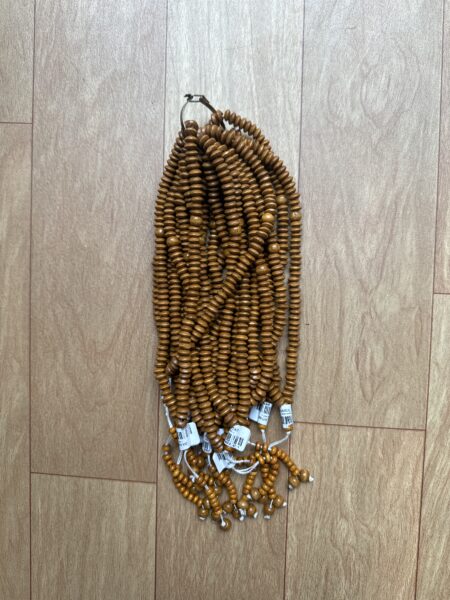Tasbih Jko 05Cm
₹40.00 Original price was: ₹40.00.₹25.00Current price is: ₹25.00.
- tasbih-jko-05cm
- 99 Beads: Representing the 99 names of Allah. These beads are divided into three sets of 33 by smaller divider beads.
- 33 Beads: Alternatively, some Tasbihs have 33 beads, used to recite “Subhan Allah” (Glory be to God), “Alhamdulillah” (Praise be to God), and “Allahu Akbar” (God is the Greatest) 33 times each.
- Divider Beads: These are slightly larger beads that separate the sets, helping the user keep count.
- Imam Bead: A larger, often elaborately designed bead that marks the starting and ending point of the Tasbih.
- Tassel: Many Tasbihs feature a decorative tassel at the end, adding a touch of elegance.

Tasbih Jko 05Cm
₹40.00Original price was: ₹40.00.₹25.00Current price is: ₹25.00.Request a Call Back
This contact form is available only for logged in users.
- Delivery & Return
How Does The Delivery Process Work ?
- Once Our System Processes Your Order, Your Products Are Inspected Thoroughly To Ensure They Are In Perfect Condition.
- After They Pass Through The Final Round Of Quality Checks, They Are Packed And Handed Over To Our Trusted Courier Partners.
- Our Delivery Partners Then Bring The Package To You At The Earliest Possibility. In Case, They Are Unable To Reach Your Provided Address Or At A Suitable Time, They Will Contact You To Resolve The Issue.
How Are Items Packed ?
We Package Our Products In Corrugated Boxes, Which Are Covered With 3 Layer Protection. Each Individual Product Is Packed In Bubble Wrap While Fragile Items Like Bottles Are Safely Secured With Additional Bubble Wrap. We Pride Ourselves On The Quality Of Our Packaging.What Is The Range Of Locations To Which Daarul Kitab & Islamic Store Ships It’s Products ?
We Shipped Our Products Pan India!My Order Has Been Shipped, How Can I Track It ?
Once Your Order Has Been Dispatched, You Will Receive An Email And SMS With Tracking Details.You Can Track The Status Of Your Order Within 24 – 48 Hours After Your Order Is Dispatched From Our Warehouse.Following Are Some Of Our Trusted Courier Partners: eKart Logistics, BlueDart, Delhivery, Xpressbees, Ecom Express, DTDC & ShadowfaxWhat Is The Estimated Delivery Time ?
It Takes 3-7 Business Days To Deliver The Order Once Order Has Been Dispatched.Though We Keep 95% Of Our Catalog In Our Inventory, Certain Products Need To Be Sourced Directly From The Brand Itself So That We Can Live Up To Our Promise Of Providing Fresh, Non-expired Products.Are There Any Shipping Charges Applicable To My Order ?
We Have Different Shipping Charges For Different Zones Which Start From 60₹ To 100₹ Is Applied To All Orders Below ₹1999, While There Is Free Shipping For All Orders Above ₹1999Note: Please Take A Video/Photos While Opening A Order You Received We Need It If Anything Goes Wrong With You Order Between Journey Of Our Warehouse To Your Doorstep, If You Find Order Is Damaged Or Intact Please Do Not Accept The Order Delivery .
Disclaimer: Any Complaints Related To Product/Delivery Should Be Brought To Our Notice Within 48 Hours From The Time Of Delivery.
Help
Give us a shout if you have any other questions and/or concerns. Email: support@daarulkitab.com Phone: +918755553311 WhatsApp: +918755553311 - Ask a Question

Tasbih Jko 05Cm
₹40.00Original price was: ₹40.00.₹25.00Current price is: ₹25.00.Ask a Question
This contact form is available only for logged in users.
Tasbih Jko 05Cm



Tasbih (also known as Misbaha, Sibha, or Subha) is a string of prayer beads commonly used by Muslims to keep track of repetitive prayers, particularly the recitation of the names of Allah, dhikr (remembrance of God), and other devotional acts. It is akin to the Rosary in Christianity or the Mala in Hinduism and Buddhism.
Historical and Cultural Significance
The practice of using Tasbih beads dates back centuries and holds deep spiritual and cultural significance. They serve as a tool to aid in concentration and mindfulness during prayer and remembrance of Allah. The Tasbih can be found in various cultures and regions, each with its unique styles and materials, reflecting local traditions and artistry.
Materials and Construction
Tasbih beads are made from a wide range of materials, each contributing to the aesthetic and tactile experience of the user:
Wood: Traditional Tasbih beads are often made from various types of wood, such as sandalwood, rosewood, or olive wood. These beads have a natural, earthy feel and are lightweight.
Semi-Precious Stones: More luxurious Tasbihs may be made from semi-precious stones such as agate, onyx, jade, or amber. These beads add a touch of elegance and are believed to hold certain spiritual properties.
Glass and Crystal: Some Tasbihs are crafted from glass or crystal beads, offering a sparkling and visually appealing option.
Plastic: Modern Tasbihs are sometimes made from high-quality plastic, providing a durable and affordable alternative.
Design and Structure
A typical Tasbih consists of:
99 Beads: Representing the 99 names of Allah. These beads are divided into three sets of 33 by smaller divider beads.
33 Beads: Alternatively, some Tasbihs have 33 beads, used to recite “Subhan Allah” (Glory be to God), “Alhamdulillah” (Praise be to God), and “Allahu Akbar” (God is the Greatest) 33 times each.
Divider Beads: These are slightly larger beads that separate the sets, helping the user keep count.
Imam Bead: A larger, often elaborately designed bead that marks the starting and ending point of the Tasbih.
Tassel: Many Tasbihs feature a decorative tassel at the end, adding a touch of elegance.
Usage in Daily Life
The Tasbih is a versatile tool used in various ways:
Daily Prayer: Used during the five daily prayers to help Muslims focus and count specific phrases of dhikr.
Personal Devotion: Carried throughout the day, the Tasbih can be used for personal remembrance and spiritual reflection.
Special Occasions: Used during special religious events such as Ramadan, Hajj, and Eid, adding to the solemnity and significance of the occasion.
Benefits of Using a Tasbih
Mindfulness and Focus: Helps maintain concentration and mindfulness during prayer and dhikr, enhancing the spiritual experience.
Ease of Counting: Facilitates counting repetitive phrases, ensuring accurate recitation.
Portable and Accessible: Small and portable, the Tasbih can be carried anywhere, allowing for spontaneous moments of remembrance.
Care and Maintenance
To ensure the longevity and beauty of your Tasbih:
Cleaning: Regularly clean the beads with a soft, damp cloth to remove dirt and oils. Avoid harsh chemicals that could damage the beads.
Storage: Store the Tasbih in a protective pouch or box to prevent damage and tangling.
Handling: Handle the beads gently, especially if they are made from delicate materials like crystal or semi-precious stones.
Conclusion
In summary, the Tasbih is a deeply meaningful and versatile tool for Muslims, aiding in the practice of dhikr and enhancing spiritual focus. Its rich history, diverse materials, and intricate designs make it both a functional and beautiful item. Whether used for daily prayers, personal devotion, or special religious occasions, the Tasbih serves as a constant reminder of faith and mindfulness.
Related Products
82 in stock
- Beautiful High Quality Islamic prayer Beads Tasbih.
- Perfect for Religious gift and personal use
2 in stock
23 in stock
- Beautiful High Quality Islamic prayer Beads Tasbih.
- Perfect for Religious gift and personal use
11 in stock
10 in stock
- Beautiful High Quality Islamic prayer Beads Tasbih.
- Perfect for Religious gift and personal use
1 in stock
25 in stock
- Beautiful High Quality Islamic prayer Beads Tasbih.
- Perfect for Religious gift and personal use
86 in stock
32 in stock
36 in stock
29 in stock
- Beautiful High Quality Islamic prayer Beads Tasbih.
- Perfect for Religious gift and personal use
40 in stock

